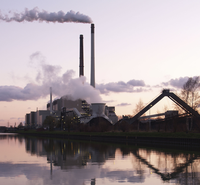
Photo from wikipedia
Recent studies have succeeded in relating emissions of various volatile organic compounds to material mass diffusion transfer using detailed empirical characteristics of each of the individual emitting materials. While significant,… Click to show full abstract
Recent studies have succeeded in relating emissions of various volatile organic compounds to material mass diffusion transfer using detailed empirical characteristics of each of the individual emitting materials. While significant, the resulting models are often scenario specific and/or require a host of individual component parameters to estimate emission rates. This study developed an approach to estimate aggregated emissions rates based on a wide number of field measurements. We used a multi-parameter regression model based on previous mass transfer models to predict formaldehyde emission rate for a whole dwelling using field-measured, time-resolved formaldehyde concentrations, air exchange rates, and indoor environmental parameters in 63 California single-family houses built between 2011 and 2017. The resulting model provides time-varying formaldehyde emission rates, normalized by floor area, for each study home, assuming a well-mixed mass balance transport model of the home, and a well-mixed layer transport model of indoor surfaces. The surface layer model asserts an equilibrium concentration within the surface layer of the emitted materials that is a function of temperature and RH; the dwelling ventilation rate serves as a surrogate for indoor concentration. We also developed a more generic emission model that is suitable for broad prediction of emission for a population of buildings. This model is also based on measurements aggregated from 27 homes from the same study. We showed that errors in predicting household formaldehyde concentrations using this approach were substantially less than those using a traditional constant emission rate model, despite requiring less unique building information.
Journal Title: International Journal of Environmental Research and Public Health
Year Published: 2022
Link to full text (if available)
Share on Social Media: Sign Up to like & get
recommendations!